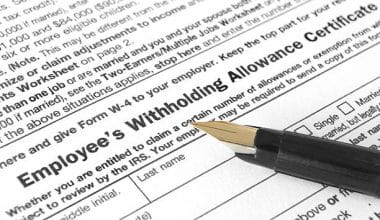Your company should present you with a W-2 tax form at the end of the year that details your annual income, taxes withheld, and perks. This form is used to file both federal and state income taxes. The amount of money you made from your employer last year and the amount of tax that was withheld from that money may be seen on your W-2. In a given year, every company that paid you $600 or a contract must provide you with a W-2 form. The W-2 is an important document for many taxpayers because it tells them if they will get a tax refund or have to pay taxes. Here is a detailed guide on how to fill out a W-2 form for an employee, the types of W-2s, and how to get one.
What Is W-2?
The W-2 form from the Internal Revenue Service (IRS) shows the taxable income you got from your employer. On the W-2, you’ll also find the taxes that have been taken out of your paycheck, as well as the Social Security and Medicare payments that you and your employer have made on your behalf.
On your W-2, you can also find important information about the federal, state, and other taxes that were taken out of your paycheck, as well as information about the benefits your employer gave you, such as health insurance, adoption and dependent care assistance, contributions to your health savings account, and more. If you are an employee, the details on your W-2 are crucial to your tax return.
If you were an employee in a given year, your company should issue you a W-2 form by early the following year.
What Is the Purpose of a W-2 Form?
The main purpose of the W-2 Form is to list employees’ wages and salaries, as well as the amount of federal, state, and local taxes withheld. By law, businesses have to give W-2 forms to employees whose taxes, Social Security, or Medicare contributions were taken out of their salary or wages.
Because independent contractors and self-employed workers pay their taxes using a different set of forms, their employers are not required to give them W-2 forms. On W-2 forms, information is given to the Internal Revenue Service and the Social Security Administration, which lets them check if a person’s income tax return is correct.
How to Fill Out a W-2 Form for an Employee
In terms of complexity, filling out a W-2 form is a breeze. Inputting data that can be available from existing sources like payroll and employee records You’ll also need some basic company information, such as an EIN and, in most places, a state-issued Taxpayer Identification Number.
However, companies have varying requirements for form completion based on things like the state in which they do business and whether or not certain employee benefits are taxable.
One of the most difficult aspects of filling out the W-2 form is being sure to spell and number all of the fields accurately. Make sure you’ve entered the correct data and that no names or addresses have been misspelled by double-checking the boxes at regular intervals. If you’re not sure how the current tax laws might affect your employees’ withholding status, you might want to talk to a tax expert. Here are some simple steps on how to fill out the W-2 form for an employee:
#1. Boxes 1-10
When filling out the right side of the W-2 form, enter the employee’s total annual earnings from wages and tips in box 1. That total does account for taxes that have been withheld, but retirement account contributions, for example, are not. Boxes 2, 4, and 6 should be used to list taxes paid to the federal government, such as income tax, Social Security, and Medicare.
Do you have a career in the food and beverage sector? Box 7 should include the number of tips the employee reports receiving, while Box 8 should include the number of tips the employee actually receives. Since 2011, when the government eliminated the pay-as-you-go option for the Earned Income Tax Credit, there has been nothing to enter in Box 9. Now, people who are eligible for the EITC get it all back at once instead of in small amounts throughout the year.
If you have any Social Security income, enter it in Box 3. Leave out any helpful hints. Due to the fact that this figure represents taxable earnings before deductions, it may be higher than the amount in Box 1.
It is possible that whatever appears in box 1 is lower than the number in box 3. Workers with incomes above the Social Security tax cap of $147,000 for the 2022 tax year (or $160,200 for the 2023 tax year) are exempt from paying Social Security taxes. There is no limit on Medicare taxable earnings; therefore, both wages and tips are included in the amount reported in box 5.
Also, any deductions for childcare costs that your workers are allowed to take should go in Box 10.
#2. Boxes 11 – 14
Box 11 is where employees should report money they got from a 457(b) plan or other non-qualified retirement plans. Schedule some time to enter the appropriate codes and amounts into Box 12 to claim your benefits and supplementary payments. On the back of the form, you’ll see 26 codes that range from A to Z and AA to EE.
In Box 13, you can use three different checkboxes to show that your worker is enrolled in your retirement plan, eligible for third-party sick pay, and a statutory employee. For example, a full-time salesperson who mostly works for one company can be considered a statutory employee even though they are technically an independent contractor.
Box 14 is for any additional deductions that weren’t already included. Also, support for education costs and fees to join a workers’ group are two examples of this.
#3. Boxes 15–20
In states that require Box 15, include your state ID number and that of each employee. Box 16 is where an employee enters their total earnings that are subject to state income tax withholding, and box 17 is where they enter the amount of state income tax that has been withheld from their paychecks. In Box 18, you must put the total amount of your local tax-taxable income.
Box 19 is where you should enter the total amount of local taxes that have been withheld. Finally, the particular name of the location to which the local taxes are attached should be written in box 20.
What Is a W-2 Salary?
Your gross pay is the amount of money you get before any withholdings or deductions are made. Your Form W-2 details the amount of your salary that is subject to taxation after withholding. Health, dental, life, and disability insurance, as well as 401(k) contributions made by an employer, are all examples of benefits that can be deducted from an employee’s paycheck before taxes are calculated.
What Is W-2 Employment in the USA?
In the U.S., each year employees get a W-2 from their employers that shows how much they were paid and what taxes were taken out of that pay. Employees’ W-2s prove that they were paid through their employer’s payroll system and that taxes were deducted during the year.
How Do I Get My W-2?
An employee is entitled to a copy of their Wage and Tax Statement (Form W-2). If your company does not make your W-2 available electronically, you must get it by January 31st via regular mail or personal delivery. Ask your company’s human resources or payroll office if you can use the internet at work.
Who Is Considered a W-2 Employee?
Employees who get a W-2 form are full-time workers who work for only one company. Managers are usually classified as W-2 workers because it is their job to oversee the work of other workers.
Also, employees with a W-2 are often paid a salary and given benefits like health insurance and plans for retirement. It is more expensive to hire W-2 workers than 1099 contractors because of the cost of providing benefits to them. Management of W-2 employees might sometimes be trickier.
New W-2 employees are subject to mandatory paperwork collection by their employers. Form W-4 is included because companies must take out their employees’ share of federal income tax from their paychecks.
What Is the Difference Between 1099 and W-2 Employees?
The difference between W-2 and 1099 employees is dependent on the tax forms used to report their wages. Employees who work 40 hours per week or more receive IRS Form W-2, which details their yearly wages and perks. Wages, salary, and tips for independent contractors are reported on Form 1099.
Employees who are paid through the 1099 system are considered independent contractors rather than employees. W-2 workers, on the other hand, may be either regular or temporary employees. Unlike W-2 employees, who have more of a duty to their employers, 1099 contractors have no vested interest in staying with your company and are free to quit at any moment. This can extend to any work product that the W-2 employee creates while using company time or resources.
W-2 employees receive health insurance and a 401(k) retirement plan in exchange for their service. Individuals who are paid under the 1099 system are not entitled to these protections under the law. Instead, most people who work as 1099 contractors do so because they are participating in a temporary project or are testing the waters with a new company. In addition, W-2 employees are more common among supervisors and full-time workers who have heavy workloads on a regular basis. Also, read 1099 EMPLOYEE: Everything You Need To Know.
What Are the Advantages of Being a W-2 Employee?
Here are some advantages of being a W-2 employee:
#1. Dedicated to Your Organization
The freedom that comes with working as a contractor is a major draw for many people. They probably don’t intend to stay with you for very long, and even if they do, you’re probably not their main source of money. Employees in the traditional sense are more likely to be loyal to their company if they are treated well.
#2. Less Need for New Employee Orientation
Even though independent contractors usually know a lot about their fields of expertise, they might not know much about how your business works. Since a new contractor always needs to be onboarded, this is the case. When it comes to training, employees often only require it once.
#3. Provide Greater Stability
When it comes to the ins and outs of your organization, employees sometimes have more of an advantage over contractors when it comes to continuity. A long-term W-2 employee may be promoted to management or given the chance to replace a departing coworker.
What Is the Difference Between a W-4 Form and a W-2 Form?
Although they share a similar-sounding name, a W-4, and a W-2 are very different documents.
The first difference is in the form-preparer. To report your tax information to your employer, you must fill out a W-4 form. Your employer will give you a W-2 and send it to the Internal Revenue Service and the Social Security Administration in order to meet their annual reporting requirements.
Second, the W-4 tells your employer what information to use to figure out how much tax to take from your paycheck. On Form W-2, your employer will report your salary and the amount of tax that was withheld.
Every year, you should review your tax withholding to make sure you’re setting aside the right amount from your paychecks. You can ask your employer to change your withholding on Form W-4 if you get a big tax refund but would rather get bigger paychecks more often and pay less in taxes at the end of the year.
In the same way, if you haven’t paid enough taxes and owe the IRS money, you can give your employer a revised W-4 to have more money taken out of your paycheck. However, this can help you avoid paying taxes with your tax return and avoid penalties for not paying enough.
How Do You Secure Your W-2?
#1. Passwords
Make sure that every sensitive account you have, including your ADP account, your benefits, payroll, and bank accounts, and any other sensitive accounts that might contain tax information, has a password that is both unique and robust. In addition, avoid using the same password for many accounts, and make sure you never reveal your password to anyone.
#2. Appropriate Disposal
To prevent identity thieves from accessing personal financial information, discard and dispose of waste documents. Make sure you have completely emptied your laptop’s trash and any other locations where it may have been stored.
#3. Transfer Confidentially
Transferring documents in person is the safest option since you will have full control over the details of the handoff and there will be no middlemen between you and your tax preparer. However, here are some things to keep in mind if you need to send files digitally.
- Avoid using email to transmit private information like your W-2.
- Use a secure internet encryption program and give your tax preparer the password for electronic release. Do not send it by electronic mail.
- Use a secure file-sharing service to exchange information.
Conclusion
In conclusion, when you file your taxes, you can’t just forget about your W-2 and the information it contains.
W-2 forms outline the monetary impact of taxes on a worker’s annual salary. On top of that, they inform employees if they might receive a tax return since they overpaid.
If your W-2 has any mistakes, as an employee, you must notify your superior immediately. In addition, if the name on the form doesn’t match the Social Security card, you need a new form.
W-2 FAQs
Who should fill out the W-2 form?
If you earn $600 or more as a full- or part-time worker for an organization, you should file a W-2.
What’s Included on a W-2 Form?
- Business Information
- Employee Information
- Employee Salary
- Retirement Plan Details
- Dependent Care Benefits
What type of employees get W-2?
- Full-time employees.
- Part-time employees.
- Temporary employees.
- Seasonal employees.
Similar Posts
- Employer Health Insurance Costs: Best 2023 Practices.
- SOCIAL SECURITY HOURS: How To Apply/Complete Guide.
- HOW TO ADDRESS A PACKAGE: Addressing an item for prompt delivery
- What Tax Does Every American Have to Pay?
- ASSET-BASED LENDING: What It Is, Real estate, Bank, LLC & Reviews






